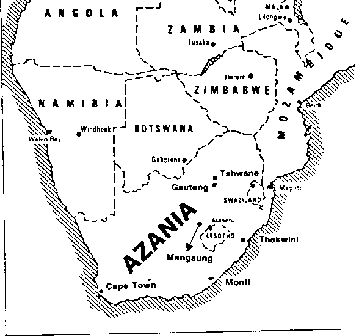Azania (Ancient Greek: Ἀζανία) is a name that has been applied to various parts of southeastern tropical Africa. In the Roman period and perhaps earlier, the toponym referred to a portion of the Southeast African coast extending from Kenya, to perhaps as far south as Tanzania.
Contents
- Ancient Azania
- Azania as an ancient continent geology
- Azania in modern usage
- Azania in literature
- References

Ancient Azania

Pliny the Elder mentions an "Azanian Sea" (N.H. 6.34) that began around the emporium of Adulis and stretched around the south coast of Africa.

The 1st century AD Greek travelogue the Periplus of the Erythraean Sea first describes Azania based on its author's intimate knowledge of the area. Chapter 15 of the Periplus suggests that Azania could be the littoral area south of present-day Somalia (the "Lesser and Greater Bluffs", the "Lesser and Greater Strands", and the "Seven Courses"). Chapter 16 clearly describes the emporium of Rhapta, located south of the Puralean Islands at the end of the Seven Courses of Azania, as the "southernmost market of Azania". The Periplus does not mention any dark-skinned "Ethiopians" among the area's inhabitants. They only later appear in Ptolemy's Geographia, but in a region far south, around the "Bantu nucleus" of northern Mozambique. According to John Donnelly Fage, these early Greek documents altogether suggest that the original inhabitants of the Azania coast, the "Azanians", were of the same ancestral stock as the Afro-Asiatic populations to the north of them along the Red Sea. Subsequently, by the 10th century AD, these original "Azanians" had been replaced by early waves of Bantu settlers.
Later Western writers who mention Azania include Claudius Ptolemy (c. 100 – c. 170 CE) and Cosmas Indicopleustes (6th century CE).
Azania was known to the Chinese as Zésàn (澤散) by the 3rd century AD.
Azania as an ancient continent (geology)
Scholars have proposed the name Azania for an ancient continent that may have existed within the Neoproterozoic Mozambique Ocean. According to Collins and Pisarevsky (2005), Azania formed a continent consisting of central Madagascar, southernmost India, parts of Somalia and east Ethiopia and Yemen; a continent first proposed (but not named) by Collins and Windley (2004). According to this hypothesis, Azania formed a part of the early Mesoproterozoic Congo-Tanzania-Bangweulu Block and rifted off in the earliest Neoproterozoic. By 850 Ma, a west (present coordinates) dipping subduction zone developed on the east side of the island and a continental arc formed through much of Azania (in Madagascar this is the Itremo-Itsindro suite). Azania collided with East Africa at about 640 Ma forming the East African Orogeny. This was followed by Neoproterozoic India colliding with the now amalgamated Azania-Congo continent at approximately 550 Ma to form the Malagasy Orogeny.
Azania in modern usage

In South Africa, the majority of the black nationalist groups including the PAC and AZAPO use the name to refer to South Africa. They officially denote the name as the Pan-Africanist Republic of Azania. They also believe that it should be the official name of South Africa.
Azania in literature
""Azania" was the fictional East African nation (closely based on Ethiopia) in the "outrageously un-politically correct tale" Black Mischief by the English author, Evelyn Waugh. The capital of Waugh's Azania was the fictional "Debra Dowa" town, based on the real Dire Dawa.
